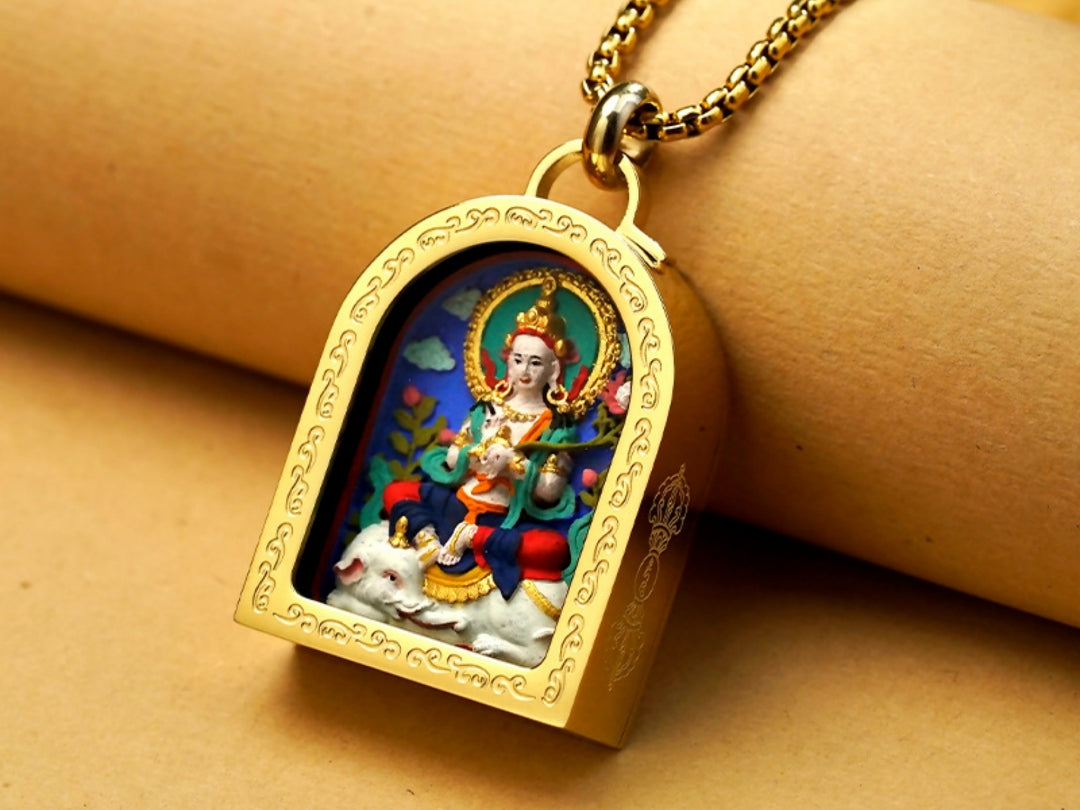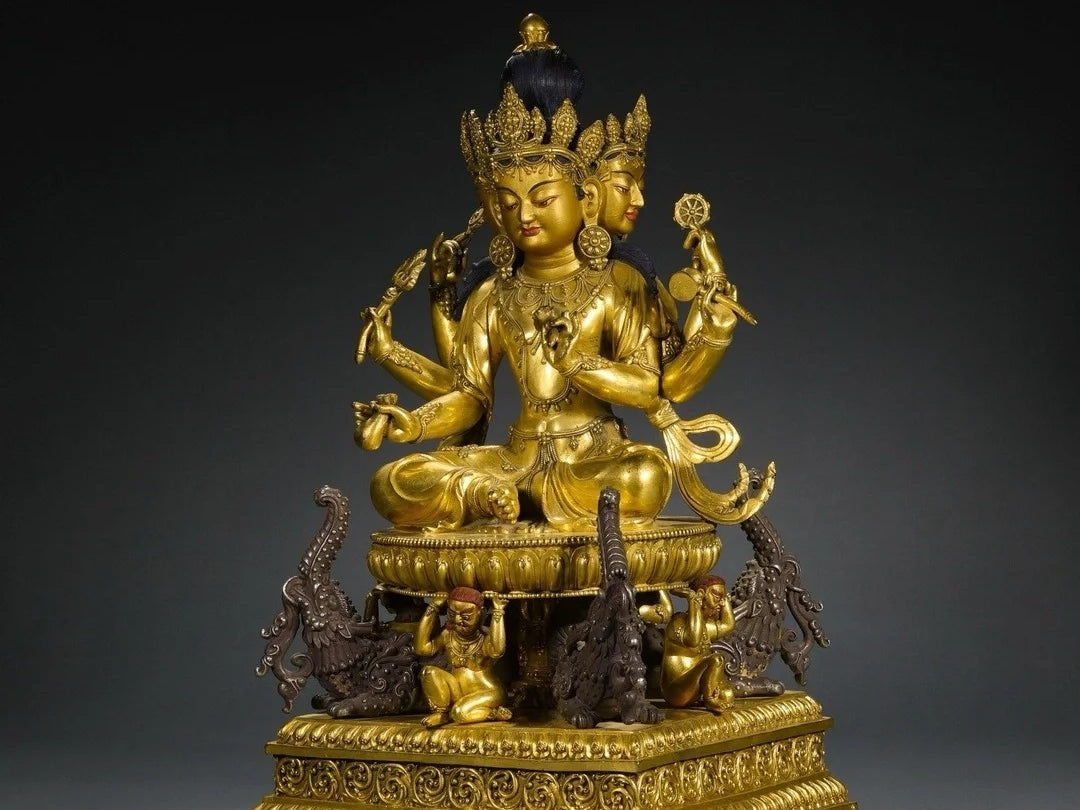In Tibetan Buddhism, Marīcī Bodhisattva (摩利支天菩萨), also called Marīcī, Marīcīdevī, or Marīcīdevī Bodhisattva, is revered as a powerful guardian deity. Her name—meaning “ray of light” or “flame of the sun”—echoes her ability to illuminate dark places and remain unseen by both divine and mortal eyes. Across centuries and cultures, Marīcī has protected rulers, warriors, and ordinary devotees from danger. In this article, we’ll trace her origins, recount famous legends, and examine her enduring significance as a Tibetan protector deity and source of inspiration for spiritual amulets and jewelry.

Origins and Cross-Cultural Roots
-
From Vairocana’s Radiance to Marīcī’s Light
-
One tradition holds that Marīcī is an emanation of Vairocana Buddha (毗卢遮那佛). As the cosmic Buddha’s wisdom radiates outward, it is said that these rays evolved into Marīcī’s own form—shining invisibly across the ten directions to aid sentient beings.
-
In this account, Marīcī emerges from the “Indestructible Realm” (Ajātaśatruloka), the deepest plane of the “Four Uncompounded Heavens.” From there, she took up the mission of safeguarding the Dharma and its practitioners.
-
-
Hindu Origins as Varāhī, the Boar-Headed Goddess
-
Before Buddhist integration, Marīcī existed in Hindu mythology as Varāhī, the boar-headed form of the Mother Goddess. She served as a warrior goddess and attendant to Indra’s sun chariot, ultimately becoming “Goddess of the Dawn.”
-
At Nālandā University in ancient India, archaeologists have uncovered early statues of Varāhī, indicating her widespread worship centuries before Buddhism assimilated her into the Vajradhātu (Diamond Realm) pantheon.
-
As Buddhist missionaries carried the teachings north, Varāhī’s attributes of light and concealment were reinterpreted, transforming her into Marīcī Bodhisattva—a protector who moves unseen and dispels obstacles.
-
-
Marīcī in Chinese and Tibetan Context
-
When Buddhism reached China, Marīcī quickly gained a following. She was honored with titles such as “Bright Mother of the Dharma” (光明佛母) and “Accumulated Light Mother” (积光佛母).
-
In Tibet, her image fused Indian and Chinese iconography. Most commonly depicted with three faces (one calm, one boar-faced, one wrathful) and six or eight arms, Marīcī’s many arms carry implements like lotus flowers, vajra-axes, and bows—symbols of both mercy and fierce protection.
-

Legendary Tales of Marīcī’s Protection
1. Song Dynasty Emperor Gaozong’s Escape
-
Historical Context: During the Southern Song’s retreat from advancing Jin forces, Emperor Gaozong (南宋高宗) and his court fled southward to safety.
-
Legend: As Jin troops closed in, the emperor and his entourage found themselves cornered. In desperation, Gaozong prayed before a Marīcī statue, beseeching her to shield them.
-
Miraculous Outcome: Witnesses claimed that enemy soldiers marched past the emperor’s party without seeing them. Safely hidden, Gaozong and his court escaped unharmed—an event attributed entirely to Marīcī’s power of invisibility.
-
Legacy: In gratitude, Gaozong brought the Marīcī image to Lin’an (present-day Hangzhou) and enshrined her in Fajing Temple (法净寺), establishing it as Marīcī’s special seat of worship.

2. Li Jue’s Divine Encounter and Longevity
-
Historical Context: In the late Tang period (9th–10th centuries), the realm was wracked by warlords and banditry.
-
Legend: Li Jue (李珏), the prefect of Bizhou (modern-day Biyang in Henan), fled conflict only to be pursued by soldiers. Exhausted and fearing for his life, Li encountered a pale-blue divine figure on the road—who revealed that Li’s name was slated for death records and offered a path to survival.
-
Practice: The deity instructed Li to recite Marīcī’s mantra 700 times daily, dedicating the merit to celestial beings.
-
Result: Li’s death sentence was erased, and his life was spared. He and others who faithfully practiced Marīcī’s dhāraṇī (protective chant) likewise escaped danger.
3. Su Shi’s Nephew Saved from Floodwaters
-
Historical Context: During the Northern Song (11th century), literary figure Su Shi (苏轼) and his family traveled along the treacherous Yangtze tributaries.
-
Legend: Su Shi’s nephew found himself on a boat caught in sudden torrential floods in the lower river gorges. Clinging to life, he remembered the Marīcī dhāraṇī often recited in Su family gatherings. Chanting the protective verse, he reportedly watched the raging currents parting around his boat, allowing safe passage to shore.
4. Zheng He’s Seven Voyages Under Marīcī’s Aegis
-
Historical Context: Zheng He (郑和; 1371–1433), the famed Ming-dynasty admiral, led seven maritime expeditions to Southeast Asia, South Asia, and East Africa.
-
Legend: At the end of his inscribed edition of the “Dhāraṇī Sūtra of Marīcī Bodhisattva”, Zheng He recorded two accounts of miraculous rescues attributed to Marīcī’s power.
-
Result: Each of Zheng He’s seven voyages returned safely to port, despite storms, pirates, and unknown seas—an outcome credited to Marīcī’s ever-watchful protection and his steadfast devotion to her practice.
Marīcī’s Role as Dharma Protector and “War Goddess”
-
Invisible Guardian
-
Marīcī’s signature ability is complete concealment—both from mortal eyes and celestial observers. Vajrayāna texts describe her walking ahead of the sun itself, remaining unseen even by Surya (the sun god).
-
Because of this, she is invoked not only for literal stealth (by ancient warriors and ninja) but also metaphorically, to remove obstacles that remain hidden or to protect one’s spiritual progress from subtle hindrances.
-
-
Disaster Remover and Wealth Bringer
-
In addition to shielding devotees from physical danger, Marīcī is believed to eliminate misfortune—such as disease, famine, or political unrest—by transforming karmic conditions.
-
Over time, her role expanded to include “granting wealth” and “securing victory in debate (dharmic contest).” Thus, she is sometimes called both guardian of life and “war goddess.”
-
-
High Status Among Protectors
-
Although Marīcī belongs to the Twelve Devas (二十四诸天) pantheon, she often is honored with the title “Great Marīcī Bodhisattva” (大摩利支菩萨), reflecting her importance as a guardian of the Buddha’s teachings and practitioners.
-
Her teachings appear in the Marīcī Sūtra, which details her invincible powers and the benefits of her mantra practice.
-
Contemporary Benefits
- Stealth in Daily Life: Modern “invisibility” need not be literal—by invoking Marīcī’s power, some wearers find renewed confidence to navigate difficult conversations or office politics without drawing undue attention.
- Disaster Prevention: In climates prone to natural calamities, devotees display Marīcī thangkas or amulets at home entrances—believing her invisible shield wards off floods, lightning strikes, and malicious energies.
- Spiritual Resilience: Chanting Marīcī’s mantra before meditation or yoga practice helps some practitioners dissolve hidden anxieties, reinforcing a sense of inner safety.

Conclusion
Marīcī Bodhisattva’s journey from an ancient Vedic dawn goddess to a central guardian in Tibetan Buddhism illustrates her unparalleled role as both light-bringer and invisible protector. Legends of Emperor Gaozong, Li Jue, Su Shi’s nephew, and Zheng He all demonstrate how her unwavering shield has preserved lives and livelihoods across millennia.
For contemporary practitioners, Marīcī remains a beacon of hope—welcoming those who seek to cultivate inner quietude, safety, and prosperity. At QiLing Aura, her energy is woven into each Tibetan protector amulet, hand-painted pendant, and hand-engraved silver charm—allowing wearers to carry her radiant armor wherever life’s path may lead.
Invoke Marīcī today: recite her mantra at dawn, don a Marīcī-inspired amulet, and rest in the confidence that her invisible protection is ever-present, guiding you through every shadowed challenge toward the dawn of understanding.



